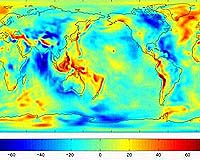| . |  |
. |
Stockholm, Sweden (UPI) Aug 17, 2009 Governments must adapt to more storms, shortages, droughts and floods because of climate change, experts said at the World Water Week 2009 in Stockholm. "Climate change is to a very large extent about water change," said Anders Berntell, head of the Stockholm International Water Institute. "Because it's through water that we will first and foremost experience climate change -- too much water, too little water, water in the wrong place at the wrong time." The SIWI organizes World Water Week 2009, a conference bringing together some 2,000 politicians, experts and business leaders to discuss issues including water availability, health, conflicts over resources and climate change. The latter has dramatic effects on water, Berntell said. "When it comes to food or energy production, there will be severe effects, and we haven't started preparing yet," he said. Climate change is expected to decrease the availability of fresh water, a commodity already unevenly distributed. In Asia, global warming could cause a water-related catastrophe, observer say. "Glaciers in the Himalayan region are beginning to melt severely," said Jakob Granit of SIWI. "There is being a period now where water has actually increased due to the melting into aquifers. But over time, that runoff water will decrease, and that will have an even larger impact. About 1 billion people will be affected in the long run." Climate change will also increase the frequency of droughts and severe storms, with potentially catastrophic consequences for many world regions, experts warn. "The typhoon hitting the south east China sea has caused the Chinese government to move about 1 million people from the provinces," Granit said. After a disaster, a population is weakened, traumatized and vulnerable to outbreaks of diseases such as cholera and dysentery, the experts say. Then, access to clean water and sanitation facilities is key to minimize secondary death tolls. "There are many communities in the developing world who are already affected by flooding and droughts and who would benefit from relatively straightforward and cheap measures to safeguard their lives and livelihoods," said Alastair Morrison, of the U.N. Development Program's water governance department. Staying in refugee camps with unsatisfactory conditions, in turn, causes stress and may even reignite old conflicts, he added. According to UNICEF, almost 1 billion people lack access to safe water. Every day approximately 4,500 children die before their fifth birthday due to unsafe water, sanitation and hygiene, the group says. "Simple, affordable and effective interventions such as hand washing with soap and water help reduce the incidence diarrheal morbidity -- the second biggest killer of children under five -- by up to 47 percent," UNICEF said in a statement. One of the speakers at the conference is Bindeshwar Pathak, who invented a clean and energy-efficient toilet system linked to fermentation plants. Besides producing odor-free bio gas, the system also releases clean water. The toilet system has improved sanitation in India, a country notorious for avoidable diseases, and it won him a $150,000 prize that he will receive at this week's conference. The United Nations declared 2005-2015 the international decade of water, in a bid to speed up the millennium goals. Water Week 2009 comes less than six months before a U.N.-mandated conference in Copenhagen, Denmark, is due to agree on a global climate protection agreement. Share This Article With Planet Earth
Related Links Water News - Science, Technology and Politics
 Satellites Unlock Secret To Northern India's Vanishing Water
Satellites Unlock Secret To Northern India's Vanishing WaterIrvine CA (SPX) Aug 17, 2009 Using satellite data, UC Irvine and NASA hydrologists have found that groundwater beneath northern India has been receding by as much as 1 foot per year over the past decade - and they believe human consumption is almost entirely to blame. More than 109 cubic kilometers (26 cubic miles) of groundwater disappeared from the region's aquifers between 2002 and 2008 - double the capacity of ... read more |
|
| The content herein, unless otherwise known to be public domain, are Copyright 1995-2009 - SpaceDaily. AFP and UPI Wire Stories are copyright Agence France-Presse and United Press International. ESA Portal Reports are copyright European Space Agency. All NASA sourced material is public domain. Additional copyrights may apply in whole or part to other bona fide parties. Advertising does not imply endorsement,agreement or approval of any opinions, statements or information provided by SpaceDaily on any Web page published or hosted by SpaceDaily. Privacy Statement |